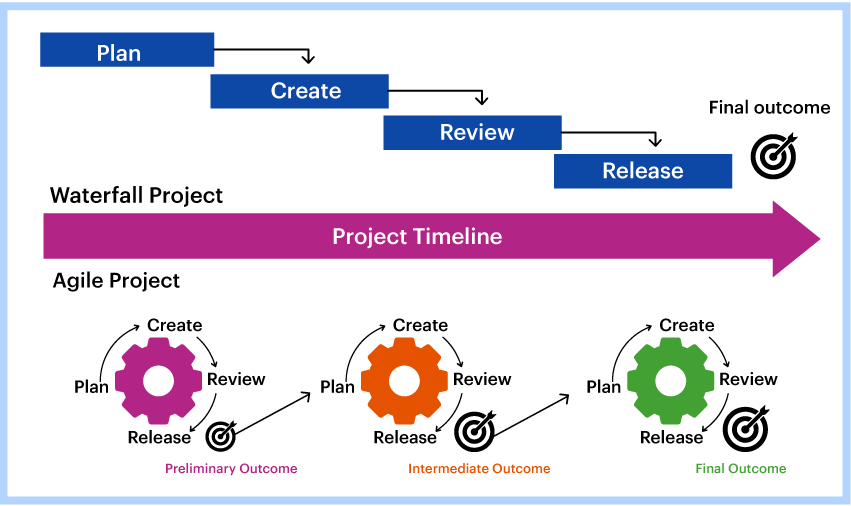
In today’s fast-paced world, project management has become a must. It has evolved into a necessary component for the proper operation of businesses. Every business size from small to large relies on Agile project management to successfully provide its products and services.
In recent years, a variety of project management and methodologies have been available all around the world. And Agile is one of the most widely used project management methodologies. Even 71 percent of businesses believed that agile principles should be used frequently, occasionally, and always. So most of the senior authorities of organizations go for Agile Project Management Certification Courses.
Let’s gain insight into the distinctions between traditional and agile project management in this post to learn what sets them apart. So, without further ado, let’s get started!
What is Project Management in the Traditional Sense?
The linear approach is the focus of traditional project management. This project management method is known as the “waterfall approach” in the agile world. In agile project management certification training, we get an overview of traditional management also.
All project phases are completed sequentially in the traditional approach. Plan, design, build, test, user acceptance, deployment, release, and so on are all defined stages in this strict, top-down methodology.
Traditional project management cannot be used to produce complicated products because it eliminates the ability to change requirements. However, statistics show that the waterfall or traditional technique fails approximately 21% of the time, while the agile approach fails only 8% of the time.
What is Agile Project Management and How Does It Work?
Creating a new product and launching it into the market is no easy task. You must develop a strategy, plan the execution, oversee the entire project, and then complete the final step.
However, in today’s fast-paced world, it’s impossible to plan everything out in advance. Traditional plans always run the risk of product delivery being delayed. You’ll eventually become uncompetitive in the marketplace.
It is here that the term “Agile” enters the picture. Agile project management is a relatively new method of project management. Although Hirotaka Takeuchi and Ikujiro Nonaka first suggested the concept in a paper in 1986, they later released (New New Product Development Game) and the agile manifesto in 2001. It became popular during the 2008-09 financial crisis and is still a novel technique for many businesses. The phrase agile denotes nimbleness and agility.
The agile technique now includes a variety of project management methods and frameworks. Scrum, Kanban, LeSS, SAFe, and Scrumban methodologies. These strategies are ideal for saving time, boosting customer happiness, and fostering decision-making throughout the product development process.
There are substantial distinctions between traditional and agile project management methodologies. In our next point, we’ll take a short look at all of the key contrasts between traditional and agile project management.
The Differences Between Traditional and Agile Project Management

1. Flexibility
The agile project management methodology is far more adaptable than traditional project management. If your team members feel the need to make modifications to their product or work process while they’re working, agile project management empowers them to do so. Agile project management certification does not adhere to a tight structure and instead focuses on the product. People love the agile project management strategy due to its flexibility.
Traditional or waterfall project management, on the other hand, takes a top-down strategy. That means you won’t be able to handle any last-minute modifications without having an impact on the work process or results.
2. Transparency
Every decision and plan in agile project management is transparent. Everyone is involved in making decisions and modifications, including the product owner, team members, and clients. The agile technique allows team members to see the work progress in detail and make educated decisions while developing, reviewing, and testing a product.
In the traditional project management technique, on the other hand, the project manager is in charge of all major decisions or works with a small group of senior members. Other team members are unable to see the progress in the form of deliverables from beginning to end.
3. Feedback’s Scope
When designing or building a new product using the traditional process, you must plan everything from the start. That implies you can’t make any big adjustments based on customer feedback that might cause the product’s delivery to be delayed.
The agile strategy, on the other hand, allows you to take frequent feedback from the product owner and customers. Continuous feedback can assist you in achieving greater results and meeting deadlines while delivering high-quality items. As a result, developers and project managers prefer agile project management to traditional project management. Most of them do agile project management certification training or agile project management certification with scrum master certification.
4. Project Complexity
All difficult jobs are well-suited to agile project management. If your project’s stages are interrelated or are dependent on one another, the agile approach is the ideal way to make work clear and reduce complexity. Frequent inspections and adaptations aid in the reduction of complexity and ambiguity in requirements.
While traditional project management methodologies use a linear approach, they are incapable of managing complicated projects with ambiguous requirements and complex activities. As previously said, you can’t make drastic adjustments to this strategy. Traditional is a better choice for undertakings that aren’t as complicated or as little.
5. Customer Satisfaction
In the agile framework, customers play a critical role. It places a greater emphasis on exceeding client expectations by embracing input after each iteration. Work is delivered to end customers on a continuous basis in agile. As a result, individuals can contribute their useful ideas and motivate the agile team to properly act on feedback.
Because agile project management places a high priority on client feedback, the team is able to comprehend the customer’s needs and deliver high-quality products and services. It aids in the retention of customers and the improvement of satisfaction.
6. Ownership and Accountability
Another reason developers and managers prefer agile project management to the traditional approach is ownership and accountability. Each team member has ownership and accountability for the project in agile. Everyone in the agile team contributes equally to completing a project within the deadline.
In traditional project management, on the other hand, the project manager is the sole proprietor of the project. Customers can be involved in the planning stage, but their participation ends once the strategy is put into action.
What Project Management Methodology Should I Use?

The debate between traditional and agile project management raises the issue, “which style should I adopt for our organization?”
In evaluating the performance of these two approaches in an organization, there are a number of criteria to consider. Agile might not be the ideal option if your organization is unwilling to let team members make decisions or believes in traditional techniques.
Modern firms and software development teams, on the other hand, favor the agile process. Most of them do the Agile Project Management Certification Course. Because you’ll obtain significantly more satisfying results in agile project management certification training methods than you would with a traditional strategy. According to different surveys, agile success rates are 1.5X greater than waterfall success rates.
Among developers and managers, the term “agile” has gained popularity. And there are other reasons for agile methodology’s widespread adoption. You can expect high-quality, improved customer and client happiness, more productivity, lower costs, and time savings when you use agile.
Change happens every day, especially in today’s corporate world. As a result, agile methodology is the ideal option for businesses looking to thrive in an ever-changing industry.
Here’s a brief chart that can assist you in selecting the best project management strategy with minimal effort:
| Characteristics | Agile approach | Traditional approach |
| Structure of the organization | Agile has a fluid network structure. | The traditional strategy, which is focused on hierarchy and silos, is no longer effective. |
| requirements of the user | Input that is interactive | Well defined before implementation |
| The procedure for development | A method of delivery that evolves (incremental) | A strategy based on the life cycle (SDLC based on waterfall) |
| Participation of customers | Has a high amount of client participation | Customers are only participating in the early stages. Low level of involvement |
| Documentation for testing | Every iteration | Comprehensive planning is required. |
| The expense of restarting | Low | High |
| Approvals and reviews | Following each iteration and the final product | Leaders do extensive reviews, although the majority of the reviews are paperwork. |
| Flexibility | Budget and timeline flexibility is high | Budget and timeline flexibility is low |
Final Thoughts
Agile and traditional project management methodologies both have advantages and disadvantages. The size, money, resources, organizational processes, and timing of your project determine which framework is ideal for your organization. When you choose the ideal project management framework and agile project management with scrum certification before you begin a project, you ensure its success from the start.
Author :
Comments are closed.










so much fantastic information on here, : D.
Thank you Michel!
I want to to thank you for this fantastic read!! I absolutely loved every little bit of it. I’ve got you saved as a favorite to look at new stuff you post…